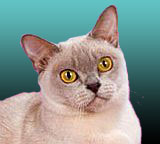|
(Following is an excerpt from the CFA breed description)
The European Burmese is a very affectionate, intelligent, and loyal cat. They thrive on companionship and will want to be with you, participating in everything you do. While they might pick a favorite family member, chances are that they will interact with everyone in the home, as well as any visitors that come to call. They are inquisitive and playful, even as adults. Expect them to be in your lap whenever you sit down and snuggle up next to you in bed. They become fast friends to other cats and even dogs, making them the perfect addition to your family.
Taking care of a European Burmese is very easy. They do not require bathing, and regular grooming with a rubbertype brush will keep shedding under control. "Scratching" is a natural behavior for all cats, so a scratching post should be provided. Sharp claws can also be trimmed with clippers. Keeping such a rare treasure indoors and neutering or spaying are all essential elements for giving your European Burmese a healthy, long, and joyful life.
The European Burmese is a medium sized, shorthaired cat of far eastern origins. Body type is elegant with gently rounded contours, solid boning, and excellent musculature. Eyes are large, alert, and expressive, with color ranging from yellow to amber. Coat colors include brown, chocolate, blue, lilac, cream, and a soft apricot red. Tortoiseshell colors are also popular.
The European Burmese and the Burmese we know in North America originated from the same source - Wong Mau, the first Burmese introduced to the Western world by Dr. Thompson in 1930. As Wong Mau was the only example of her type, she had to be mated to another breed of similar type. The obvious choice then was the Siamese. Resulting litters revealed that Wong Mau herself carried a pointed gene, as kittens in her litters were both solid and pointed in color.
The solids were selected for further propagation of the breed. From the United States, the breed spread east to the United Kingdom, where the same lack of breeding stock led again to the introduction of the Siamese. From then on, the breed followed different courses of development; today we have two very different looking cats with two different standards, both sharing a common ancestry.
The most obvious difference between the breeds is the array of colors displayed by the European Burmese - ten to be exact. Introduction of the red gene is responsible for the additional colors. This gene was introduced both deliberately and by accident. In the U.K., Siamese come in many colors, including red points, so the introduction of this gene to the existing four colors (brown, chocolate, blue, and lilac) produced the colors red, cream, brown-tortie, chocolate-tortie, blue-tortie, and lilac-tortie.
There is also a difference in type between the two Burmese breeds. The European Burmese is an elegant, moderate cat with gently rounded contours, whereas the Burmese has a compact, well rounded appearance. The eye shape differs between the two breeds. The European Burmese should have eyes with a top line that is slightly curved, with a slant towards the nose. The lower line should be rounded. The Burmese eyes should have a rounded aperture.
|
The Asian Group of cats consists of five varieties: Self, which includes the Bombay (Black Self) and 16 other recognized self and tortie colors; Asian Smoke; Asian Shaded, called Burmilla; Asian Tabby, which includes Ticked, Mackerel, Spotted and Classic tabby patterns; and the semi-longhaired version which is called the Tiffanie.
The Asian breed originated in the UK from a mismating between a Lilac European Burmese queen and a Chinchilla Persian boy, the resulting litter of four kittens was born in 1981. These very attractive kittens led to a decision to begin work to develop a new breed, and to work towards eventual GCCF recognition. Early breeders decided that the desired phenotype should be exactly the same as that of the Burmese progenitor, but with a range of new colors, patterns and with two hair-lengths: shorthair and semi-longhair. The breed was named "Asian" and by 2003 all five varieties had reached GCCF Championship Status.
Exactly similar to the Burmese in type, all cats in this group have a short, fine and glossy coat, except for the Tiffanie, which has a fine silky semi-longhaired coat. The Asian is a slender, athletic cat of medium size. Heavy for their size, they are muscular and lithe, with a broad rounded chest, slender elegant legs and neat oval paws. Tail is of medium thickness and tapers evenly to the tip. The head forms a short wide blunt wedge with a slightly rounded top, medium to medium large ears are spaced well apart. The eyes are large and lustrous, with colors ranging from pale green through shades of green and yellow chartreuse to golden yellow and amber. Asians come in a wide range of colors: Black, Blue, Chocolate, Lilac, Cinnamon, Fawn, Caramel, the tortie versions of all these colors, and Red, Cream and Apricot, in both full expression and Burmese Color Restriction. Silver and non-silver versions are recognized in all colors and patterns.
The Asian is a lively outgoing cat - lithe and energetic, they enjoy play, are very affectionate and want to be part of all aspects of their owner's life. Intelligent and inquisitive, they can be very curious and determined with a love of investigating new things. They are not particularly noisy, but are talkative and chatty and will readily answer their owner when addressed. The Asian is a "people cat." Loving, charming and entertaining, they make a good family pet and associate well with dogs and children providing they are properly introduced. Males usually weigh around 5 - 7 kg (11 - 15 lbs) and females weigh less, with a breed average weight of 3.5 - 5.5 kg (8 - 12 lbs). Life expectancy average is about 16-18 years.
|















